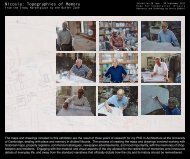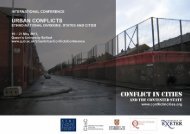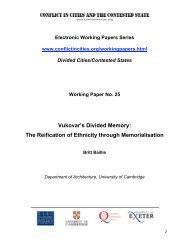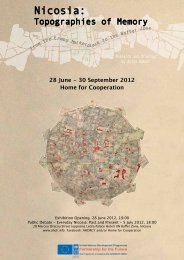Post-conflict reconstruction in Mostar: Cart before the Horse
Post-conflict reconstruction in Mostar: Cart before the Horse
Post-conflict reconstruction in Mostar: Cart before the Horse
You also want an ePaper? Increase the reach of your titles
YUMPU automatically turns print PDFs into web optimized ePapers that Google loves.
Triumph of emblems, and <strong>the</strong> alternatives<br />
Beh<strong>in</strong>d <strong>the</strong> scenes of <strong>Mostar</strong>'s postwar recovery, dist<strong>in</strong>ct schools of thought were at work.<br />
The more powerful and political actors, <strong>in</strong>clud<strong>in</strong>g <strong>the</strong> European Union, UNESCO, and <strong>the</strong><br />
World Bank, tended to believe that emblematic projects would be <strong>the</strong> most feasible and<br />
immediately beneficial to <strong>the</strong> residents of <strong>Mostar</strong>. This strategy was grounded <strong>in</strong> <strong>the</strong> notion<br />
that a semblance of normality could generate reforms to actually make it so. Some of <strong>the</strong><br />
less powerful actors <strong>in</strong> <strong>the</strong> city, <strong>in</strong>clud<strong>in</strong>g representatives of foreign non-governmental<br />
organisations, regional universities, and municipal agencies related to <strong>reconstruction</strong><br />
activities, advocated for <strong>in</strong>cremental <strong>in</strong>vestments designed to address <strong>the</strong> needs of typical<br />
residents. Many small projects focused on education, health, and improved dialogue<br />
between ethnic rivals. These reflected an assumption that emblematic reforms should<br />
crown a series of less visible, more ord<strong>in</strong>ary ones.<br />
The emblematic approach to <strong>reconstruction</strong> prevailed between 1994 and 2004. One of<br />
<strong>the</strong> first important decisions that was made, almost implicitly, among external donors was to<br />
focus <strong>the</strong>ir efforts and resources on <strong>the</strong> physical fabric of a broken city - as a prerequisite<br />
for all forms of social rehabilitation, it might have been argued at <strong>the</strong> time. The trickle-down<br />
model of confidence-build<strong>in</strong>g and revitalisation was put to a severe test. It proved<br />
disappo<strong>in</strong>t<strong>in</strong>g for a number of reasons - most notably: stubbornly oversimplified<br />
<strong>in</strong>terpretations of <strong>the</strong> reasons for <strong>conflict</strong>, rigid dichotomisation of political actors and<br />
cynicism regard<strong>in</strong>g <strong>the</strong> capacity of local professional actors to assume responsibility for <strong>the</strong><br />
implementation of major programme components.<br />
This last observation is especially tell<strong>in</strong>g. Given <strong>the</strong>ir decision to emphasise large-scale<br />
architectural projects, foreign donors faced a fundamental choice between streng<strong>the</strong>n<strong>in</strong>g<br />
exist<strong>in</strong>g local agencies - a process that would often have required <strong>in</strong>tegration of two or more<br />
offices <strong>in</strong> <strong>the</strong> city, east and west, that had resulted from <strong>the</strong> general bifurcation of <strong>Mostar</strong> -<br />
or creat<strong>in</strong>g new ones. No doubt <strong>the</strong> prospect of forc<strong>in</strong>g unwill<strong>in</strong>g or even hostile local actors<br />
to collaborate appeared untenable to many outsiders. New offices, appear<strong>in</strong>g redundant<br />
with respect to exist<strong>in</strong>g ones, came <strong>in</strong>to existence on a project-by-project basis beg<strong>in</strong>n<strong>in</strong>g <strong>in</strong><br />
1995. Each was staffed with capable local professionals supported and often supervised by<br />
foreign professionals whose neutrality and competence were presumably beyond question.<br />
Many of <strong>the</strong>se new offices bore little or none of <strong>the</strong> legal authority held by <strong>the</strong>ir<br />
counterparts <strong>in</strong> <strong>the</strong> municipal government. Still, superior fund<strong>in</strong>g and staff<strong>in</strong>g often made<br />
<strong>the</strong>m resources of first resort as work on <strong>the</strong> ground progressed and <strong>the</strong> need for reliable<br />
<strong>in</strong>formation <strong>in</strong>tensified. Good examples of this phenomenon <strong>in</strong>clude <strong>the</strong> Project coord<strong>in</strong>ation<br />
13







